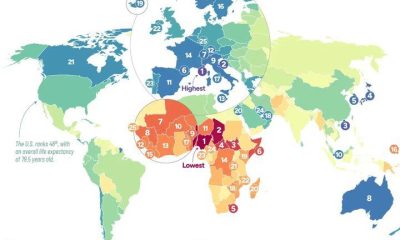Business
Ad Fraud: The digital advertising scourge
Published
3 years agoon
By
Reuben Kalu
Digital advertising has been an integral part of the modern business landscape for over two decades now, with its market size expected to reach $526 billion by 2024. It has undoubtedly revolutionized the way businesses reach their target audience, allowing them to tap into a vast pool of online users across multiple channels.
However, with this growth, there has also been a steady rise in a major challenge that has plagued the digital advertising industry for years – Ad fraud. In simple terms, ad fraud is the deliberate practice of deceiving advertisers by manipulating their ad campaigns to generate fake impressions, clicks, and conversions to drive revenue to fraudulent sources. This has become a significant problem in the digital advertising space, causing billions of dollars in financial losses to advertisers, publishers, and platforms alike.
In this article, we’ll take a closer look at ad fraud in digital advertising, its impact on the industry, and ways to combat it.
What is Ad Fraud?
Ad fraud is a fraudulent activity that occurs in digital advertising where fraudsters generate invalid or fake impressions, clicks, or conversions to deceive advertisers, making them believe their ad campaign is successful when, in reality, it is not. Ad fraud can take many forms, including:
Bot Fraud: Bot fraud occurs when fraudsters use automated software, commonly known as bots, to generate fake impressions, clicks, and conversions. These bots are programmed to mimic human behavior and can be controlled from a single point, creating massive volumes of fake traffic.
Click Fraud: Click fraud occurs when fraudsters intentionally click on ads to generate revenue for themselves or to deplete their competitors’ advertising budgets. This can also happen when fraudsters use click farms or groups of people paid to click on ads repeatedly.
Conversion Fraud: Conversion fraud occurs when fraudsters create fake conversions or leads by providing false information such as fake email addresses, phone numbers, or personal data.
Impact of Ad Fraud on the Industry
Ad fraud has become a significant problem in the digital advertising industry, affecting all players in the ecosystem – advertisers, publishers, and ad tech platforms. The financial implications of ad fraud are staggering, with estimates suggesting that advertisers lose between $6 billion to $16 billion per year to ad fraud globally.
Loss of Revenue: Ad fraud is a direct financial loss for advertisers, who pay for fake impressions, clicks, and conversions generated by fraudsters. This translates into a loss of revenue for advertisers who are unable to reach their target audience, which results in reduced ROI.
Brand Safety: Ad fraud can negatively impact brand safety, as fraudsters may use legitimate ads to promote malicious content or fake products, damaging the brand’s reputation and causing mistrust among consumers.
Negative User Experience: Ad fraud can also cause a negative user experience, as fraudulent ads may redirect users to sites that are irrelevant or harmful, leading to frustration and annoyance.
Publisher Losses: Publishers are also victims of ad fraud, as they lose revenue when fraudsters manipulate their inventory to generate fake impressions and clicks.
Regulatory Issues: Ad fraud also creates regulatory issues, as regulators may penalize advertisers and ad tech platforms for fraudulent activities, causing reputational damage and financial losses.
How to Combat Ad Fraud
Ad fraud is a complex problem that requires a multifaceted approach to combat it effectively. Here are some strategies that can be used to combat ad fraud:
Ad Verification: Ad verification involves using third-party tools to verify ad impressions and clicks to ensure that they are coming from real users and not bots. Ad verification tools can also detect fraud by analyzing the behavior of users and identifying suspicious patterns.
Bot Detection: Bot detection tools can help detect and prevent bot traffic by analyzing user behavior and identifying anomalies that may indicate the suspicious activity and alert advertisers and publishers to potential fraud. Ad fraud detection software can help detect and prevent fraudulent clicks and impressions on ads. This software uses advanced algorithms and machine learning to identify.
Work with Trusted Partners: Advertisers and publishers should work with trusted partners who have a reputation for transparency and accountability. This can help reduce the risk of ad fraud and ensure that ad campaigns are running as intended.
Monitor Ad Campaigns Closely: Advertisers and publishers should monitor their ad campaigns closely to identify any suspicious activity. This can involve analyzing performance metrics, monitoring traffic sources, and checking for any irregularities in ad behavior.
Implement Strong Security Measures: Advertisers and publishers should implement strong security measures to protect against ad fraud. This can involve using encryption, two-factor authentication, and other security protocols to prevent unauthorized access to ad campaigns.
Conclusion
Ad fraud is a significant issue in the digital advertising industry, and it affects all stakeholders in different ways. Advertisers lose money, publishers lose revenue and reputation, and consumers are exposed to irrelevant or misleading ads.
Trending

 Comments and Issues1 week ago
Comments and Issues1 week agoNigeria’s Life Expectancy as World’s Lowest

 Health1 week ago
Health1 week agoFDA expands probe into COVID-19 vaccine-linked deaths

 Latest7 days ago
Latest7 days agoChristmas rush triggers surge in transport fares from Lagos to South-East

 Latest1 week ago
Latest1 week agoEight UNIJOS students, driver killed as trailer crashes into bus

 Comments and Issues1 week ago
Comments and Issues1 week agoProtecting A Neighbor While Failing Nigerians: A Misplaced Priority?

 Uncategorized6 days ago
Uncategorized6 days agoCVR: INEC records 139,251 applications in Lagos

 Labour1 week ago
Labour1 week agoPolice debunk viral video claiming officer caught stealing, arrests 13 for assault

 Business6 days ago
Business6 days agoNCC moves to resolve Abuja network disruptions, blames diesel supply crisis

